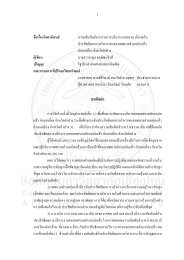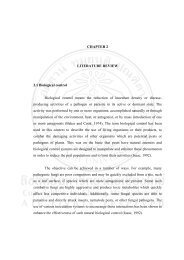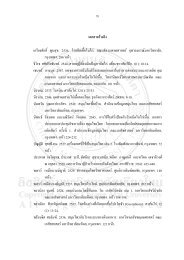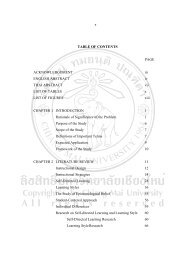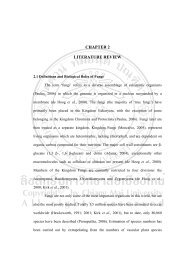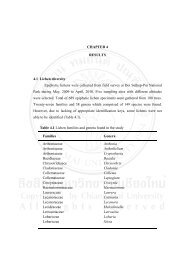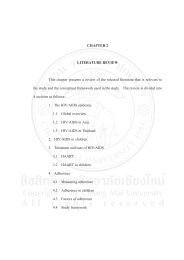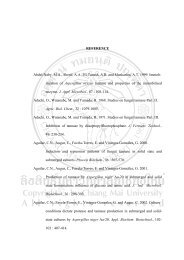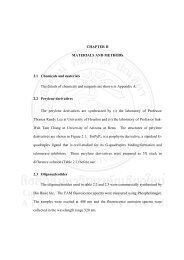REFERENCES 1. Andrus, M.R. and Roth, M.T. Health literacy: A ...
REFERENCES 1. Andrus, M.R. and Roth, M.T. Health literacy: A ...
REFERENCES 1. Andrus, M.R. and Roth, M.T. Health literacy: A ...
You also want an ePaper? Increase the reach of your titles
YUMPU automatically turns print PDFs into web optimized ePapers that Google loves.
<strong>REFERENCES</strong><br />
<strong>1.</strong> <strong>Andrus</strong>, M.R. <strong>and</strong> <strong>Roth</strong>, M.T. <strong>Health</strong> <strong>literacy</strong>: A review. Pharmacotherapy. 2002;<br />
22(3): 282-302.<br />
2. Ngoh, L.N. <strong>and</strong> Shepherd, M.D. Design, development, <strong>and</strong> evaluation of visual<br />
aids for communicating prescription drug instructions to nonliterate patients<br />
in rural Cameroon. Patient Educ Couns. 1997; 30: 245-26<strong>1.</strong><br />
3. Dowse, R. <strong>and</strong> Ehlers, M.S. Pictograms in pharmacy. Int J Pharm Pract. 1998;<br />
June: 109-118.<br />
4. Houts, P.S., Witmer, J.T., Egeth, H.E. et al. Using pictographs to enhance recall of<br />
spoken medical instruction II. Patient Educ Couns. 2001; 43: 231-242.<br />
5. National Statistical Office. 1970 Population & Housing Census: Whole Kingdom,<br />
Office of the Prime Minister, Bangkok, Thail<strong>and</strong>, 1970.<br />
6. National Statistical Office. 1980 Population & Housing Census: Whole Kingdom,<br />
Office of the Prime Minister, Bangkok, Thail<strong>and</strong>, 1980.<br />
7. National Statistical Office. 1990 Population & Housing Census: Whole Kingdom,<br />
Office of the Prime Minister, Bangkok, Thail<strong>and</strong>, 1990.<br />
8. National Statistical Office. 2000 Population & Housing Census: Whole Kingdom,<br />
Office of the Prime Minister, Bangkok, Thail<strong>and</strong>, 2002.<br />
9. National Statistical Office. 1994 Report of the Literacy Survey Office of the<br />
Prime Minister, Bangkok, Thail<strong>and</strong>, 1994.
153<br />
10. Thompson, C.A. <strong>Health</strong> il<strong>literacy</strong> interferes with care. Am J <strong>Health</strong> Sys Pharm.<br />
2001; 58(July 15): 1294-1295.<br />
1<strong>1.</strong> Ad Hoc Committee on <strong>Health</strong> Literacy for the Council of Scientific Affairs,<br />
American Medical Association. <strong>Health</strong> <strong>literacy</strong>: report of the council on<br />
Scientific Affairs. JAMA. 1999; 281(February): 552-557.<br />
12. Youmans, S.L., <strong>and</strong> Schillinger, D. Functional health <strong>literacy</strong> <strong>and</strong> medication use:<br />
the pharmacist’s role. Ann Pharmacother. 2003; 37(November): 1726–1729.<br />
13. Gazmararian, J.A., Baker, D.W., Williams, M.V. et al. <strong>Health</strong> <strong>literacy</strong> among<br />
Medicare enrollees in a manage care organization. JAMA. 1999. 281(6): 545-<br />
55<strong>1.</strong><br />
14. Weiss, B.D., Hart, G., McGee, D.L. et al. <strong>Health</strong> status of illiterate adults: relation<br />
between <strong>literacy</strong> <strong>and</strong> health status among persons with low <strong>literacy</strong> skills.<br />
J Am Board Fam Pract. 1992; 5(May-June): 257-264.<br />
15. Baker, D.W., Parker, R.M., Williams, M.V. et al. The relationship of patient<br />
reading ability to self-reported health <strong>and</strong> use of health services. Am J Public<br />
<strong>Health</strong>. 1997; 87(June): 1027-1030.<br />
16. National Work Group on Literacy <strong>and</strong> <strong>Health</strong>. Communicating with patients who<br />
have limited <strong>literacy</strong> skills. J fam Pract. 1998; 46(February): 168-176.<br />
17. Weiss, B.D., Hart, G. <strong>and</strong> Pust, R.E. The relationship between <strong>literacy</strong> <strong>and</strong> health.<br />
J <strong>Health</strong> Care Poor Underserved. 1991; 1(4): 351-363.<br />
18. Hanson, E.C. Evaluating cognitive services for Non-literate <strong>and</strong> visually impaired<br />
patients in community pharmacy rotation sites. Am J Pharm Ed. 1995;<br />
59(Spring): 48-55.
154<br />
19. Hanson, E.C. <strong>and</strong> Hartzema, A. Evaluating pictograms as an aid for counseling<br />
elderly <strong>and</strong> low-literate patients. J Pharm Market Manag. 1995; 9(3): 41-54.<br />
20. Weiss, B.D. <strong>and</strong> Coyne, C. Communicating with patients who cannot read. The N<br />
Engl J Med. 1997; 24(July): 272-274.<br />
2<strong>1.</strong> Dowse, R. <strong>and</strong> Ehlers, M.S. The evaluation of pharmaceutical pictograms in a<br />
low-literate South African population. Patient Educ Couns.. 200<strong>1.</strong> 45: 87-99.<br />
22. Mayeaux, E.J., Murohy, P.W., Arnold, C. et al. Improving patient education for<br />
patients with low <strong>literacy</strong> skills. Am Fam Phys. 1996; 53(January): 205-21<strong>1.</strong><br />
23. Weiss, B.D., Blanchard, J. S., McGee, D.L. et al. Il<strong>literacy</strong> among Medicaid<br />
recipients <strong>and</strong> its relationship to health care costs. J <strong>Health</strong> Care Poor<br />
Underserved. 1994; 5(2): 99-11<strong>1.</strong><br />
24. Rymes-Barley, C. A secret inability to comply: The price of Il<strong>literacy</strong>. Can pharm<br />
J. 1989; February: 86-93.<br />
25. Rossof, A.H. Non-compliant, or illiterate?. Lancet. 1988; 1:362.<br />
26. Frankel, D.H. Think horses, not zebras. Lancet. 1987; 2: 1515-1516.<br />
27. Work, D.R. Improving drug labels with pictograms. Int Pharm J. 1990; 4(4): 153-<br />
157.<br />
28. Dowse, R., <strong>and</strong> Ehlers, M. Medicine labels incorporating pictograms: do they<br />
influence underst<strong>and</strong>ing <strong>and</strong> adherence?. Patient Educ Couns. 2005; 58: 63–<br />
70.<br />
29. Baker, D.W., Parker, R.M., Williams, M.V., et al. The health care experience of<br />
patients with low <strong>literacy</strong>. Arch Fam Med. 1996; 5(June): 329–334.
155<br />
30. Davis, T.C., Crouch, M.A., Wills, G. et al. The gap between patient reading<br />
comprehension <strong>and</strong> the readability of patient education materials. J Fam<br />
Pact. 1990; 31(5): 533-538<br />
3<strong>1.</strong> Davis, T.C., Mayeaux, E.J., Fredrickson, D. et al. Reading ability of parents<br />
compare with reading level of pediatric patient education materials.<br />
Pediatrics. 1994; 93: 460-468.<br />
32. Larson, I. <strong>and</strong> Schumacher, H.R. Comparison of <strong>literacy</strong> level of patients in a VA<br />
arthritis Center with the reading level required by educational materials.<br />
Arthritis Care Res. 1992; 5(1): 13-16.<br />
33. Powers, R.D. Emergency department patient <strong>literacy</strong> <strong>and</strong> the readability of<br />
patient-direction materials. Ann Emerg Med. 1988; 17(2): 124-126.<br />
34. Jolly, B.T., Scott, J.L., Feied, C.F. et al. Functional il<strong>literacy</strong> among emergency<br />
department patients: a preliminary study. Ann Emerg Med. 1993; 22(3): 573-<br />
578.<br />
35. Katz, M.G., Kripalani, S., <strong>and</strong> Weiss, B.D. Use of pictorial aids in medication<br />
instructions: A review of the literature. Am J <strong>Health</strong> Sys Pharm. 2006;<br />
63(23): 2391-2397.<br />
36. Dixon, E., <strong>and</strong> Park, R. Do patients underst<strong>and</strong> written health information?. Nurs<br />
Outlook. 1990; 38(6): 278-28<strong>1.</strong><br />
37. Meade, C.D., <strong>and</strong> Byrd, J.C. Patient <strong>literacy</strong> <strong>and</strong> the readability of smoking<br />
education literature. Am J Public <strong>Health</strong>. 1989; 79(2): 204-206.<br />
38. Spadero, D.C. Assessing readability of patient information materials. Pediatric<br />
Nurs. 1983; 9: 274-277.
156<br />
39. Doak, L.G., <strong>and</strong> Doak, C.C. Patient comprehension profile: recent findings <strong>and</strong><br />
strategies. Patient Counselling <strong>and</strong> <strong>Health</strong> Education. 1980; 2(3): 101-106.<br />
40. Loguori, S. A quantitative assessment of the readability of PPI’s. Drugh Intell clin<br />
Pharm. 1978, 12(December): 712-716.<br />
4<strong>1.</strong> Mansoor, L.E., <strong>and</strong> Dowse, R. Effect of pictograms on readability of patient<br />
information materials. Ann Pharmacother. 2003; 37: 1003–9.<br />
42. Fredrickson, D.D., Washington, R.L., Pham, N. et al. Reading grade levels <strong>and</strong><br />
health behaviors of parents at child clinics. Kansas Med. 1995; 96(3): 127-<br />
129.<br />
43. Davis, T.C., Wolf, M.S., Bass, P.F. et al. Literacy <strong>and</strong> misunderst<strong>and</strong>ing<br />
prescription drug labels. Ann Intern Med. 2006; 145(12): 887-894.<br />
44. Pruckkumvong, N. An inquiry into the feasibility of total pictorial directions on<br />
medication labels. Faculty of Pharmacy, Mahidol University, 1982.<br />
45. Chantasart, A. Perception <strong>and</strong> underst<strong>and</strong>ing of the outpatients on medicines<br />
obtained from Samut Songkhram Hospital. Independent Study, Graduate<br />
School, Chiang Mai University, 1994.<br />
46. Chalawtham, N. Underst<strong>and</strong>ing of label drug comm<strong>and</strong> by out-patient of<br />
Nakorning Hospital, Chiang Mai. A special problem, Faculty of Pharmacy,<br />
Chiang Mai University, 1995.<br />
47. Hardie, N.R., Gagnon, J.P. <strong>and</strong> Eckel, F.M. Feasibility of symbolic directions on<br />
prescription labels. Drug Intell Clinl Pharm. 1979. 13 (October): 588-595.<br />
48. Dowse, R., <strong>and</strong> Ehlers, M.S. The influence of education on the interpretation of<br />
pharmaceutical pictograms for communicating medicine instructions. Int J<br />
Pharm Pract. 2003; 11:11–8.
157<br />
49. Houts, P.S., Bachrach, R., Tringali, C.A. et al. Using pictographs to enhance recall<br />
of spoken medical instructions. Patient Educ Couns. 1998. 35: 83-88.<br />
50. Sojourner, R.J., <strong>and</strong> Wogalter, M.S. The influence of pictorials on the<br />
comprehension <strong>and</strong> recall of pharmaceutical safety <strong>and</strong> warning information.<br />
Int J Cogn Ergon. 1998; 2(1-2): 93–106.<br />
5<strong>1.</strong> Houts, P.S., Doak, C.C., Doak., L.G. et al. The role of pictures in improving<br />
health communication: a review of research on attention, comprehension,<br />
recall, <strong>and</strong> adherence. Patient Educ Couns. 2006; 61: 173–190.<br />
52. Jumput, W. <strong>and</strong> Khunthahall, S. The underst<strong>and</strong>ing of pictograms: a case study in<br />
third year pharmacy students Chiang Mai University. A special problem,<br />
Faculty of Pharmacy, Chiang Mai University, 1997.<br />
53. Samerkum, K., Kanman, K. <strong>and</strong> Deethae. The devevelopment <strong>and</strong> evaluation of<br />
pictorial auxiliary labels in increasing recall of medication information: a<br />
case study among outpatients, Chiang Mai Neurological Hospital <strong>and</strong><br />
Nakornping Hospital, Chaing Mai Province. A special problem, Faculty of<br />
Pharmacy, Chiang Mai University, 2003.<br />
54. Polnok. A., Wanwithayapha. A., Chuealek, U. et al. Interpretation of USP<br />
Pharmaceutical pictograms by Thai subjects. The fifth Indochina Conference<br />
on Pharmaceutical Sciences: Pharmacy for Sustainable Development,<br />
Bangkok, Thail<strong>and</strong>, 2007. p. 83.<br />
55. Noyprom, S. <strong>and</strong> Srichachwal, S. Outpaitents’ underst<strong>and</strong>ing of USP-DI<br />
pictograms at Her Royal Highness Princess Maha Chakri Sirindhorn Medical<br />
Center (abstract). Thai Pharm <strong>Health</strong> Sci J. 2006; 1(3): 270-<strong>1.</strong>
158<br />
56. Tohnahun, H. <strong>and</strong> Bunpok, T. Underst<strong>and</strong>ing of general suggestion in medicine<br />
use among outpatients. Chiang Mai Municipality Hospital, A special<br />
problem, Faculty of Pharmacy, Chiang Mai University, 2003.<br />
57. Sungpong, P. <strong>and</strong> Ratanaburee, A. Evaluation of pictorial labeling for pharmacy.<br />
Community Pharmacy Association (Thail<strong>and</strong>). 1999; 1(November): 12-14.<br />
58. Nilaward, K., Samerkum, K., Kanman, K. et al. Effect of pictorial auxiliary labels<br />
on patients’ recall of medication use information. SWU J Pharm Sci. 2005;<br />
10(2):162-168.<br />
59. National Statistical Office. 1990 Population & Housing Census: The Northern<br />
Region, Office of the Prime Minister, Bangkok, Thail<strong>and</strong>, 1990.<br />
60. National Statistical Office. 1990 Population & Housing Census: The Southern<br />
Region, Office of the Prime Minister, Bangkok, Thail<strong>and</strong>, 1990.<br />
6<strong>1.</strong> National Statistical Office. 1990 Population & Housing Census: The Central<br />
Region, Office of the Prime Minister, Bangkok, Thail<strong>and</strong>, 1990.<br />
62. National Statistical Office. 1990 Population & Housing Census: The Northeastern<br />
Region, Office of the Prime Minister, Bangkok, Thail<strong>and</strong>, 1990.<br />
63. National Statistical Office. 2000 Population & Housing Census: The Northern<br />
Region, Office of the Prime Minister, Bangkok, Thail<strong>and</strong>, 2000.<br />
64. National Statistical Office. 2000 Population & Housing Census: The Southern<br />
Region, Office of the Prime Minister, Bangkok, Thail<strong>and</strong>, 2000.<br />
65. National Statistical Office. 2000 Population & Housing Census: The Central<br />
Region, Office of the Prime Minister, Bangkok, Thail<strong>and</strong>, 2000.<br />
66. National Statistical Office. 2000 Population & Housing Census: The Northeastern<br />
Region, Office of the Prime Minister, Bangkok, Thail<strong>and</strong>, 2000.
159<br />
67. National Statistical Office. 1970 Population & Housing Census: The Northern<br />
Region, Office of the Prime Minister, Bangkok, Thail<strong>and</strong>, 1970.<br />
68. National Statistical Office. 1980 Population & Housing Census: The Northern<br />
Region, Office of the Prime Minister, Bangkok, Thail<strong>and</strong>, 1980.<br />
69. Parker, R.M., Baker, D.W., William, M.V. et al. The test of functional health<br />
<strong>literacy</strong> in adults: a new instrument for measuring patients’ <strong>literacy</strong> skills. J<br />
Gen Intern Med. 1995; 10 (October): 537-541<br />
70. Bohlman, L.N., Panzer, A.M. <strong>and</strong> Kindig, D.A. (Ed.), <strong>Health</strong> <strong>literacy</strong>: a<br />
prescription to end confusion. Washington, DC: the National Academies<br />
Press., pp. 31-107, 2004.<br />
7<strong>1.</strong> Osborne, H. <strong>Health</strong> <strong>literacy</strong> from A to Z: practical ways to communicate your<br />
health. Jones <strong>and</strong> Bartlett Publishers, Inc., 2005.<br />
72. Kirsch, I., Jungeblut, A., Jenkins, L. et al. Adult <strong>literacy</strong> in American: a first look<br />
at the findings of the national adult <strong>literacy</strong> survey. Washington, DC:<br />
National Center for Education Statistics, U.S. Department of education.<br />
1993.<br />
73. Bernhardt, J.M., Brownfield, E.D. <strong>and</strong> Parker, R.M. Underst<strong>and</strong>ing <strong>Health</strong><br />
<strong>literacy</strong>. in Schwartzberg, J.G., VanGreest, J.B. <strong>and</strong> Wang, C.C. (Ed.),<br />
Underst<strong>and</strong>ing health <strong>literacy</strong>: implications for medicine <strong>and</strong> public health.<br />
The American Medical Association, pp. 4-5, 2005.<br />
74. Weiss, B.D. Epidemiology of heath <strong>literacy</strong>. in Schwartzberg, J.G., VanGreest,<br />
J.B. <strong>and</strong> Wang, C.C. (Ed.), Underst<strong>and</strong>ing health <strong>literacy</strong>: implications for<br />
medicine <strong>and</strong> public health. The American Medical Association, pp. 17-39,<br />
2005.
160<br />
75. Baker, D.W. The meaning <strong>and</strong> the measure of health <strong>literacy</strong>. J Gen Intern Med.<br />
2006; 21: 878-883.<br />
76. DeWalt, D.A., Berkman, N.D., Sheridan, S. et al. Literacy <strong>and</strong> health outcomes: a<br />
systematic review of the literature. J Gen Intern Med. 2004; 19: 1129–1139.<br />
77. Koo, M.M., Krass, I. <strong>and</strong> Aslani, P. Factor influencing consumer use of written<br />
drug information. Ann Pharmacother. 2003; 37(February): 259-267.<br />
78. Zarcadoolas, C., Pleasant, A. <strong>and</strong> Greer, D.S. Underst<strong>and</strong>ing health <strong>literacy</strong>: an<br />
exp<strong>and</strong>ed model. <strong>Health</strong> Promot Int. 2005; 20(2): 195-203.<br />
79. Eustace, C.A., Johnson, G.J. <strong>and</strong> Gault, M.H. Improvements in drug prescription<br />
labels for patients with limited education or vision. Can Med Assoc J 1982;<br />
127: 301-302.<br />
80. National Statistical Office. Report of the Literacy Survey 1985, Office of the<br />
Prime Minister, Bangkok, Thail<strong>and</strong>, 1985.<br />
8<strong>1.</strong> DeWalt, D.A. <strong>and</strong> Pignone, M. <strong>Health</strong> <strong>literacy</strong> <strong>and</strong> heath outcome: overview of<br />
the literature. in Schwartzberg, J.G., VanGreest, J.B. <strong>and</strong> Wang, C.C. (Ed.),<br />
Underst<strong>and</strong>ing health <strong>literacy</strong>: implications for medicine <strong>and</strong> public health.<br />
The American Medical Association, pp. 205-227, 2005.<br />
82. Doak, C., Doak, L., <strong>and</strong> Root, J. Teaching patients with low <strong>literacy</strong> skills, 2nd ed.<br />
Philadelphia, Pa: JB Lippincott Co., 1996.<br />
83. Kripalani, S., Henderson, L.E., Chiu, E.Y. et al. Predictors of medication selfmanagement<br />
skill in a low-<strong>literacy</strong> population. J Gen Intern Med. 2006; 21:<br />
852–856.
161<br />
84. Davis, T., Kennen, E.M., Gazmararian, J.A. et al. Literacy testing in health care<br />
research. in Schwartzberg, J.G., VanGreest, J.B. <strong>and</strong> Wang, C.C. (Ed.),<br />
Underst<strong>and</strong>ing health <strong>literacy</strong>: implications for medicine <strong>and</strong> public health.<br />
The American Medical Association, pp. 157-179, 2005.<br />
85. Brez, S.M. <strong>and</strong> Taylor, M. Assessing <strong>literacy</strong> for patient teaching: perspectives of<br />
adults with low <strong>literacy</strong> skills. J Adv Nurs. 1997; 25: 1040-1047.<br />
86. Baker, D.W., Williams, M.V., Parker, R.M. et al. Development of brief test to<br />
measure functional health <strong>literacy</strong>. Patient Educ Couns. 1999; 38: 33-42.<br />
87. Parikh, N.S., Parker, R.M., Nurss, J.R. et al. Shame <strong>and</strong> heath <strong>literacy</strong>: the<br />
unspoken connection. Patient Educ Couns. 1996; 27: 33-39.<br />
88. Loughrey, L. Dealing with the illiterate patient. You can’t read him like a book.<br />
Nursing. 1983;January: 65-67.<br />
89. Hardie, L.R. Counseling patient with low health <strong>literacy</strong>. Am J <strong>Health</strong>-syst Pharm.<br />
2005; 62: 364-365.<br />
90. Wileman, R.E. Visual Communicating, Englewood Cliffs: New Jersey<br />
Educational Technology Inc., 1993.<br />
9<strong>1.</strong> Rohret, L. <strong>and</strong> Ferguson, K.J. Effective use of patient education illustrations.<br />
Patient Edu Couns. 1990; 15: 73–75.<br />
92. Mansoor, L.E. <strong>and</strong> Dowse, R. Design <strong>and</strong> evaluation of a new pharmaceutical<br />
pictogram sequence to convey medicine usage. Ergonomics SA. 2004; 2:<br />
29-41<br />
93. Sexton, T. Visual materials: how much can we communicate?. Int J <strong>Health</strong> Educ.<br />
1970; 13: 88-90.
162<br />
94. Knapp, P., Raynor, D.K., Jebar, A.H. et al. Interpretation of medication<br />
pictograms by adults in the UK. Ann Pharmacother. 2005; 39: 1227-1233.<br />
95. United States Pharmacopoeia dispensing information, vol. II. Rockville (MD):<br />
United States Pharmacopeial Convention Inc., 1996.<br />
96. Cairney, P. <strong>and</strong> Sless, D. Communication effectiveness of symbolic safety signs<br />
with different user groups. Appl Ergon. 1982; 13: 91-97.<br />
97. Colle, R. <strong>and</strong> Glass, S. Pictorial conventions in development communication in<br />
developing countries. Media Edu Dev. 1986; 19: 159–162.<br />
98. Davies, S., Haines, H., Norris, B. et al. Safety pictograms: are they getting the<br />
message across?. Appl Ergon. 1998; 29: 15–23.<br />
99. Sansgiry, S.S., Cady, P.S., <strong>and</strong> Adamcik, B.A. Consumer comprehension of<br />
information on over-the-counter medication labels: effects of picture<br />
superiority <strong>and</strong> individual differences based on age. J Pharm Mark Manage.<br />
1997; 11: 63–76.<br />
100. Morrow, D.G., Hier, C.M., Menard, W.E. et al. Icons improve older <strong>and</strong> younger<br />
adults’ comprehension of medication information. J Gerontol B Psychol Sci<br />
Soc Sci. 1998; 53B: 240–254.<br />
10<strong>1.</strong> Hämeen-Anttila, K., Kemppainen, K., Enlund, H. et al. Do pictograms improve<br />
children's underst<strong>and</strong>ing of medicine leaflet information?. Patient Educ<br />
Couns. 2004; 55: 371–378.<br />
102. Kassam, R., Vaillancourt, L.R., <strong>and</strong> Collins, J.B. Pictographic instructions for<br />
medications: do different cultures interpret them accurately? Int J Pharm<br />
Pract. 2004; 12: 199–209.
163<br />
103. Courtejoie, J. <strong>and</strong> Herman, F. Producing visual aids in Central Africa. Int J<br />
<strong>Health</strong> Educ. 1965; 8: 174-178.<br />
104. Vincent, M. Cultural differences in the planning of visual aids. Int J <strong>Health</strong> Educ.<br />
1972; 4: 259-268.<br />
105. Morris, S.L. <strong>and</strong> Schulz R.M. Patient compliance—an overview. J Clin Pharm<br />
Ther. 1992; 17: 283–295.<br />
106. Bernardini, C., Ambrogi, V., Perioli, L.C. et al. Comprehensibility of the package<br />
leaflets of all medicinal products for human use: a questionnaire survey<br />
about the use of symbols <strong>and</strong> pictograms. Pharmacol Res. 2000; 41:<br />
679–688.<br />
107. Morrow DG, Leirer VO, <strong>and</strong> Andrassy JM. Using icons to convey medication<br />
schedule information. Appl Ergon. 1996; 27:267–275.<br />
108. Moynihan, M. <strong>and</strong> Mukherjee, U. Visual communication with non-literates: a<br />
review of current knowledge including research in northern India. Int J<br />
<strong>Health</strong> Educ. 1981; 24: 251-262.<br />
109. Morrell, R.W., Park, D.C., <strong>and</strong> Poon, L.W. Effects of labeling techniques on<br />
memory <strong>and</strong> comprehension of prescription information in young <strong>and</strong> old<br />
adults. J Gerontol. 1990; 45: 166–172.<br />
110. Perry, M.A. <strong>and</strong> Furukawa, M.J. Modeling methods. in: Kanfer, F.H., <strong>and</strong><br />
Goldstein, A.P. (Ed.), Helping people change: a textbook of methods. New<br />
York: Pergamon Press., pp. 131-171, 1988.<br />
11<strong>1.</strong> B<strong>and</strong>ura, A. Principles of behavior modification. New York: Holt, Rinehart <strong>and</strong><br />
Winston, Inc., 1969.
164<br />
112. Crain, W. B<strong>and</strong>ura’s social learning theory. in Theories of development:<br />
concepts <strong>and</strong> applications, 5th ed. New Jersey: Prentice-Hall Inc., pp. 197-<br />
216, 2005.<br />
113. B<strong>and</strong>ura, A. Social learning theory. Englewood Cliffs, New Jersey: Prentice-<br />
Hall, Inc., 1977.<br />
114. McGuire, W. J. Constructing social psychology: creative <strong>and</strong> critical processes.<br />
New York: Cambridge University Press., 1999.<br />
115. Sansgiry, S.S. <strong>and</strong> Sikri, S. How patients view pharmacy benefit plans <strong>and</strong><br />
management strategies. Drug Ben Trends. 2004; 16(7): 380-392.<br />
116. Gourley, G.K., Gourley, D.R., La Monica, E. et al. Development <strong>and</strong> validation<br />
of the pharmaceutical care satisfaction questionnaire. Am J Manage Care.<br />
2001; 7(5): 461-466.<br />
117. Grogan, S., Conner, M., Norman, P. et al. Validation of a questionnaire<br />
measuring patient satisfaction with general practitioner services. Quality in<br />
<strong>Health</strong> Care. 2000; 9: 210-215.<br />
118. Margolis, S.A., AL-Marzouqi, S., Revel, T. et al. Patient satisfaction with<br />
primary health care services in the United Arab Emirates. Int J Quality in<br />
<strong>Health</strong> Care. 2003; 15: 241-249.<br />
119. Ware, J.E. How to survey patient satisfaction. Drug Intell Clinl Pharm. 1981;<br />
15(November): 892-899.<br />
120. John, J.A., Coons, S.J. <strong>and</strong> Hay, R.D. The structure of satisfaction with pharmacy<br />
service. Med Care. 1998; 36(2): 244-250.
165<br />
12<strong>1.</strong> Schommer, J.C., Wenzel, R.G. <strong>and</strong> Kucukarslan, S.N. Evaluation of pharmacists’<br />
services for hospital inpatients. Am J <strong>Health</strong> Syst Pharm. 2002; 59(17):<br />
1632-1637.<br />
122. Kucukarslan, S.N. <strong>and</strong> Schommer, J.C. Measuring patient satisfaction with<br />
pharmaceutical services. Am J <strong>Health</strong> Syst Pharm. 1997; 54(December):<br />
2721-2732.<br />
123. Kucukarslan, S.N. <strong>and</strong> Schommer, J.C. Patients’ expectations <strong>and</strong> their<br />
satisfaction with pharmacy services. J Am Pharm Assoc. 2002; 42(3): 489-<br />
496.<br />
124. Somani, S.M., Daniels, C.E. <strong>and</strong> Jermstad, R.L. Patient satisfaction with<br />
outpatient pharmaceutical services. Am J Hosp Pharm. 1982; 39(June):<br />
1025-1027.<br />
125. Johnson, K.A., Parker, J.P., McCombs, J.S. et al. The Kaiser Permanente/ USC<br />
patient consultation study: patient satisfaction with pharmaceutical services.<br />
Am J <strong>Health</strong> Syst Pharm. 1998; 55(15): 2621-2629.<br />
126. Briesacher, B. <strong>and</strong> Corey, R. Patient satisfaction with pharmaceutical services at<br />
independent <strong>and</strong> chain pharmacies. Am J <strong>Health</strong> Syst Pharm. 1997;<br />
54(5): 531-536.<br />
127. Sainumtan, W. Patient satisfaction on out-patient service at Maharaj Nakorn<br />
Chiang Mai Hospital. Independent Study, Graduate School, Chiang Mai<br />
University, 1999.<br />
128. Purasiri, K. Service recipients’ satisfaction from service of out-patient<br />
department, Chiang Mai Neurological Hospital. M.S. Independent Study,<br />
Graduate School, Chiang Mai University, 2003.
166<br />
129. Jomngam, P. Time spent <strong>and</strong> satisfaction on out patient service among clients of<br />
Lanna Hospital. Independent Study, Graduate School, Chiang Mai<br />
University, 2000.<br />
130. Chinnawat, K. Satisfaction of hospitalized patients with services at Suanprung<br />
Psychiatric Hospital. Independent Study, Graduate School, Chiang Mai<br />
University, 2003.<br />
13<strong>1.</strong> Krass, I., Svarstad, B.L. <strong>and</strong> Bultman, D. Using alternative methodologies for<br />
evaluating patient medication leaflets. Patient Educ Couns. 2002; 47: 29-35.<br />
132. Shrank, W., Avorn, J, Rolon, C. et al. Effect of Content <strong>and</strong> Format of<br />
Prescription Drug Labels on Readability, Underst<strong>and</strong>ing, <strong>and</strong> Medication<br />
Use: A Systematic Review. Ann Pharmacother. 2007; 41(5): 783 - 80<strong>1.</strong><br />
133. DeVellis, R.F., Scale development: theory <strong>and</strong> applications. Newbury Park,<br />
California: Sage Publications, Inc., p. 85, 199<strong>1.</strong><br />
134. Murphy, K.R. <strong>and</strong> Myors, B. Statistical power analysis: a simple <strong>and</strong> general<br />
model for traditional <strong>and</strong> modern hypothesis tests. New Jersey: Lawrence<br />
Erlbaum Associates, Inc., p. 17, 1998.<br />
135. Samuels, M.L. <strong>and</strong> Witmer, J.A. Statistics for the life sciences. 3rd ed. New<br />
Jersey: Prentice-Hall Inc., p. 679, 2003.




